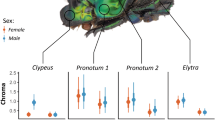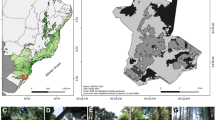Abstract
Deception has evolved in a range of taxa. When deception imposes costs, yet persists over generations, exploited species typically have traits to help them bear or minimise costs. The sexually deceptive orchids, Cryptostylis spp., are pollinated by tricking male haplodiploid wasps (Lissopimpla excelsa) into mating with flowers, which offer no reward and often elicit sperm wastage. We hypothesise that by attracting haplodiploid species, orchids have a pollinator ideally suited to withstand the costs of sexual deception—and a selective advantage compared to other orchids. Haplodiploid females can reproduce with or without sperm—albeit when spermless, females can only have sons. Through orchid deception and sperm wastage, deceived haplodiploid populations could become male biased, providing enough males to share between orchids and females. In this way, pollinator populations can persist despite high densities of sexually deceptive orchids. Here, we aim to broadly test this prediction using museum and digital records of the pollinator, L. excelsa, from sites with or without orchids. For robustness, we also analyse the sex ratio of a sister ichneumonid species that occurs in the same areas but is not deceived by orchids. We found that at sites with orchids, L. excelsa was significantly more male biased than at sites without orchids and significantly more male biased than the sister ichneumonid. This survey is the first to test the population-level effects of sexually deceptive orchids on their pollinator. It supports our prediction that orchid deception can drive male-biased sex ratios in exploited pollinators.




Similar content being viewed by others
References
Atlas of Life in the Coastal Wilderness (2019) Retrieved from www.atlasoflife.naturemapr.org/. Accessed Jan 2019
Atlas of Living Australia (2019) Retrieved from www.ala.org.au. Accessed Jan 2019
Baker GH, Tann CR, Fitt GP (2008) Production of Helicoverpa spp. (Lepidoptera, Noctuidae) from different refuge crops to accompany transgenic cotton plantings in eastern Australia. Aust J Agric Res 59:723–732
Baker GH, Tann CR (2020) Long-term changes and host plant differences in the incidence of parasitoids attacking Helicoverpa spp. (Lepidoptera: Noctuidae) in agricultural landscapes in eastern Australia. Austral Entomology 59:386–397. https://doi.org/10.1111/aen.12456
Berndt LA, Berry JA, Brockerhoff EG (2006) Parasitoids and predators of the endemic defoliator Pseudocoremia suavis (Butler) (Lepidoptera: Geometridae: Ennominae). New Zealand Entomologist 29(1):89–98. https://doi.org/10.1080/00779962.2006.9722142
Berry JA, Walker GP (2004) Meteorus pulchricornis (Wesmael) (Hymenoptera: Braconidae: Euphorinae): an exotic polyphagous parasitoid in New Zealand. New Zealand Journal of Zoology 31(1):33–44. https://doi.org/10.1080/03014223.2004.9518357
Blanco MA, Barboza G (2005) Pseudocopulatory pollination in Lepanthes (Orchidaceae: Pleurothallidinae) by fungus gnats. Ann Bot 95(5):763–772. https://doi.org/10.1093/aob/mci090
Bohman B, Flematti GR, Barrow RA, Pichersky E, Peakall R (2016) Pollination by sexual deception—it takes chemistry to work. Curr Opin Plant Biol 32(32):37–46
Bosque C, Pacheco MA (2019) Skewed adult sex ratios in Columbina ground doves from Venezuela. J Field Ornithol 90(1):1–6. https://doi.org/10.1111/jofo.12277
Boulton RA, Collins LA, Shuker DM (2015) Beyond sex allocation: the role of mating systems in sexual selection in parasitoid wasps. Biol Rev 90(2):599–627. https://doi.org/10.1111/brv.12126
BowerBird (2019) Retrieved from www.bowerbird.org.au. Accessed Jan 2019
Brunton Martin AL, O’Hanlon JC, Gaskett AC (2020) Orchid sexual deceit affects pollinator sperm transfer. Funct Ecol 34(7):1336–1344. https://doi.org/10.1111/1365-2435.13551
Cally JG, Stuart-Fox D, Holman L (2019) Meta-analytic evidence that sexual selection improves population fitness. Nat Commun 10(1):2017. https://doi.org/10.1038/s41467-019-10074-7
Calabrese JM, Ries L, Matter SF et al (2008) Reproductive asynchrony in natural butterfly populations and its consequences for female matelessness. J Anim Ecol 77:746–756. https://doi.org/10.1111/j.1365-2656.2008.01385.x
Castillo RCD, Núñez-Farfán J (2002) Female mating success and risk of pre-reproductive death in a protandrous grasshopper. Oikos 96:217–224. https://doi.org/10.1034/j.1600-0706.2002.960203.x
Coleman E (1928) Pollination of an Australian orchid by the male ichneumonid Lissopimpla Semipunctata, Kirby. Transactions of the Royal Entomological Society of London 76(2):533–539. https://doi.org/10.1111/j.1365-2311.1929.tb01419.x
Coskun M, Kayis T (2017) Change in number of males of parasitoid Pimpla turionellae L. (Hymenoptera:Ichneumonidae) affect its progeny sex ratio, longevity and adult emergence. Alatarim 88
Damiens D, Boivin G (2006) Why do sperm-depleted parasitoid males continue to mate? Behav Ecol 17(1):138–143. https://doi.org/10.1093/beheco/arj009
Farrokhi S, Ashouri A, Shirazi J, Allahvari H, Huigens ME (2010) A comparative study on the functional response of Wolbachia-infected and uninfected forms of the parasitoid wasp Trichogramma brassicae. J Insect Sci 10. https://doi.org/10.1673/031.010.14127
Bennett JH, Fisher RA, Fisher RA (1999) The genetical theory of natural selection: by R.A. Fisher; edited with a foreword and notes by J.H. Bennett (Third edition). Italy: OUP Oxford
Flickr (2019) Retrieved from www.flickr.com. Accessed Jan 2019
Ford WM, Menzel MA, Menzel JM, Welch DJ (2002) Influence of summer temperature on sex ratios in eastern red bats (Lasiurus borealis). Am Midl Nat 147(1):179–184. https://doi.org/10.1674/0003-0031(2002)147[0179:IOSTOS]2.0.CO;2
Frayssinet M, Audiot P, Cusumano A, Pichon A, Malm LE, Jouan V, … Volkoff A-N (2019) Western european populations of the ichneumonid wasp Hyposoter didymator belong to a single taxon. Front Ecol Evol 7:20. https://doi.org/10.3389/fevo.2019.00020
Gaskett AC (2011) Orchid pollination by sexual deception: pollinator perspectives. Biol Rev 86(1):33–75. https://doi.org/10.1111/j.1469-185X.2010.00134.x
Gaskett AC, Herberstein ME (2009) Colour mimicry and sexual deception by Tongue orchids (Cryptostylis). Naturwissenschaften 97(1):97. https://doi.org/10.1007/s00114-009-0611-0
Gaskett AC, Winnick CG, Herberstein ME (2008) Orchid sexual deceit provokes ejaculation. Am Nat 171(6):E206–E212. https://doi.org/10.1086/587532
Gerth M, Geibler A, Bleidorn C (2011) Wolbachia infections in bees (Anthophila) and possible implications for DNA barcoding. Syst Biodivers 9(4):319–327. https://doi.org/10.1080/14772000.2011.627953
Godfray HCJ (1990) The causes and consequences of constrained sex allocation in haplodiploid animals. J Evol Biol 3(1–2):3–17. https://doi.org/10.1046/j.1420-9101.1990.3010003.x
Godfray HCJ (1994) Parasitoids: behavioral and evolutionary Ecology. United States: Princeton University Press
Hamilton WD (1967) Extraordinary sex ratios. Science 156(3774):477–488. https://doi.org/10.1126/science.156.3774.477
Hardy ICW (1994) Sex ratio and mating structure in the parasitoid hymenoptera. Oikos 69(1):3–20. https://doi.org/10.2307/3545278
Harrell FE Jr, Califf RM, Pryor DB (1982) Evaluating the yield of medical tests. JAMA 247(18):2543–2546. https://doi.org/10.1001/jama.1982.03320430047030
Hijmans RJ (2019) Geosphere: spherical trigonometry. (R Package No. Version 1.5–10)
Holman L, Kokko H (2013) The consequences of polyandry for population viability, extinction risk and conservation. Philos Trans R Soc B: Biol Sci 368(1613):20120053. https://doi.org/10.1098/rstb.2012.0053
Hopper SD, Brown AP (2007) A revision of Australia’s hammer orchids (Drakaea: Orchidaceae), with some field data on species-specific sexually deceived wasp pollinators. Aust Syst Bot 20(3):252–285. https://doi.org/10.1071/SB06033
Hornett EA, Charlat S, Wedell N, Jiggins CD, Hurst GDD (2009) Rapidly shifting sex ratio across a species range. Curr Biol 19(19):1628–1631. https://doi.org/10.1016/j.cub.2009.07.071
Hosmer DW, Lemeshow S (2000) Applied Logistic Regression (2nd Edition). New York: John Wiley & Sons
iNaturalist (2019). Retrieved January 2019 from www.inaturalist.org
Jacob HS, Evans EW (1998) Effects of sugar spray and aphid honeydew on field populations of the parasitoid Bathyplectes curculionis (Hymenoptera: Ichneumonidae). Environ Entomol 27:1563–1568. https://doi.org/10.1093/ee/27.6.1563
Johns CV, Whitehouse MEA (2004) Mass rearing of two larval parasitoids of Helicoverpa spp. (Lepidoptera: Noctuidae): Netelia producta (Brullé) and Heteropelma scaposum (Morley) (Hymenoptera: Ichneumonidae) for field release. Aust J Entomol 43(1):83–87. https://doi.org/10.1111/j.1440-6055.2004.00402.x
King BH (1987) Offspring sex ratios in parasitoid wasps. Q Rev Biol 62(4):367–396. https://doi.org/10.1086/415618
Kokko H, Heubel KU, Rankin DJ (2008) How populations persist when asexuality requires sex: the spatial dynamics of coping with sperm parasites. Proceedings of the Royal Society of London b: Biological Sciences 275(1636):817–825. https://doi.org/10.1098/rspb.2007.1199
Kranz, Schwarz, Giles, Crespi (2000) Split sex ratios and virginity in a gall-inducing thrips. J Evol Biol 13(4):700–706. https://doi.org/10.1046/j.1420-9101.2000.00197.x
Lawrence L, Whitehouse M, Wilson L, Fitt G (2005) Comparing invertebrate communities in transgenic BT and conventional cotton. Outlooks on Pest Management; Saffron Walden, 16(5), 196–198. http://dx.doi.org.ezproxy.auckland.ac.nz/, https://doi.org/10.1564/16oct02
Lloyd RJ, Murray DAH, Hopkinson JE (2008) Abundance and mortality of overwintering pupae of Helicoverpa armigera (Hübner) (Lepidoptera: Noctuidae) on the Darling Downs, Queensland, Australia. Aust J Entomol 47:297–306. https://doi.org/10.1111/j.1440-6055.2008.00661.x
NatureShare (2019). Retrieved January 2019 from www.natureshare.org.au
Normark BB (2003) The evolution of alternative genetic systems in insects. Annu Rev Entomol 48(1):397–423. https://doi.org/10.1146/annurev.ento.48.091801.112703
O’Neill SL, Hoffmann AA, Werren JH (1997) Influential passengers: inherited microorganisms and arthropod reproduction. Oxford University Press
Pearcy M, Aron S, Doums C, Keller L (2004) Conditional use of sex and parthenogenesis for worker and queen production in ants. Science 306(5702):1780–1783. https://doi.org/10.1126/science.1105453
Phillips RD, Brown GR, Dixon KW, Hayes C, Linde CC, Peakall R (2017) Evolutionary relationships among pollinators and repeated pollinator sharing in sexually deceptive orchids. J Evol Biol 30(9):1674–1691. https://doi.org/10.1111/jeb.13125
Pipoly I, Bókony V, Kirkpatrick M, Donald PF, Székely T, Liker A (2015) The genetic sex-determination system predicts adult sex ratios in tetrapods. Nature 527(7576):91–94. https://doi.org/10.1038/nature15380
Questagame (2019) Retrieved from www.questagame.com. Accessed Jan 2019
Quicke DLJ (2014) The braconid and ichneumonid parasitoid wasps: biology, systematics, evolution and ecology. John Wiley & Sons
Rankin DJ, Kokko H (2007) Do males matter? The role of males in population dynamics. Oikos 116(2):335–348. https://doi.org/10.1111/j.0030-1299.2007.15451.x
Rautiala P, Helanterä H, Puurtinen M (2017) The evolutionary dynamics of adaptive virginity, sex-allocation, and altruistic helping in haplodiploid animals. Evolution 72(1):30–38. https://doi.org/10.1111/evo.13399
Reiter N, Bohman B, Flematti GR, Phillips RD (2018) Pollination by nectar-foraging thynnine wasps: evidence of a new specialized pollination system for Australian orchids. Bot J Linn Soc 188(3):327–337. https://doi.org/10.1093/botlinnean/boy058
Reiter N, Vlcek K, O’Brien N, Gibson M, Pitts D, Brown GR, … Phillips RD (2017) Pollinator rarity limits reintroduction sites in an endangered sexually deceptive orchid (Caladenia hastata): implications for plants with specialized pollination systems. Bot J Linn Soc 184(1): 122–136. https://doi.org/10.1093/botlinnean/box017
Rhainds M (2010) Female mating failures in insects. Entomol Exp Appl 136(3):211–226. https://doi.org/10.1111/j.1570-7458.2010.01032.x
Ridley M (1993) Clutch size and mating frequency in parasitic Hymenoptera. Am Nat 142(5):893–910. https://doi.org/10.1086/285579
Rogers ME, Potter DA (2004) Potential for sugar sprays and flowering plants to increase parasitism of white grubs (Coleoptera: Scarabaeidae) by tiphiid wasps (Hymenoptera: Tiphiidae). Environ Entomol 33:619–626. https://doi.org/10.1603/0046-225X-33.3.619
Sandanayaka WRM, Chhagan A, Page-Weir NEM, de Silva HN, Charles JG (2011) The effect of mating behaviour on progeny sex ratio of Mastrus ridens (Hymenoptera: Ichneumonidae), a biological control agent of codling moth. Biocontrol Sci Tech 21(4):485–496. https://doi.org/10.1080/09583157.2011.552103
Schiestl FP (2005) On the success of a swindle: pollination by deception in orchids. Naturwissenschaften 92(6):255–264. https://doi.org/10.1007/s00114-005-0636-y
Székely T, Liker A, Freckleton RP, Fichtel C, Kappeler PM (2014) Sex-biased survival predicts adult sex ratio variation in wild birds. Proceedings of the Royal Society b: Biological Sciences 281(1788):20140342. https://doi.org/10.1098/rspb.2014.0342
Van der Cingel NA (2001) An atlas of orchid pollination: America, Africa, Asia and Australia. A.A. Balkema Publishers, Rotterdam
Weinstein AM, Davis BJ, Menz MHM et al (2016) Behaviour of sexually deceived ichneumonid wasps and its implications for pollination in Cryptostylis (Orchidaceae). Biological Journal of the Linnean Society 119:283–298. https://doi.org/10.1111/bij.12841
Werren JH (1997) Biology of Wolbachia. Annu Rev Entomol 42(1):587–609. https://doi.org/10.1146/annurev.ento.42.1.587
Whitehouse MEA, Wilson LJ, Fitt GP (2005) A comparison of arthropod communities in transgenic Bt and conventional cotton in Australia. Environ Entomol 34(5):18
Whitehouse MEA, Cross D, Mansfield S, Harden S, Johnson AL, Harris DJ, … Downes SJ (2017) Do pigeon pea refuges in Bt cotton pull their weight as “genetic diluters” to counter Bt resistance in Helicoverpa moths? Crop Protection 100: 96–105. https://doi.org/10.1016/j.cropro.2017.05.030
Wong BBM, Salzmann C, Schiestl FP (2004) Pollinator attractiveness increases with distance from flowering orchids. Proceedings of the Royal Society of London b: Biological Sciences 271:S212–S214. https://doi.org/10.1098/rsbl.2003.0149
Author information
Authors and Affiliations
Corresponding author
Additional information
Communicated by: Tatjana Cornelissen.
Publisher's note
Springer Nature remains neutral with regard to jurisdictional claims in published maps and institutional affiliations.
Rights and permissions
About this article
Cite this article
Brunton Martin, A.L., Gaskett, A.C. & O’Hanlon, J.C. Museum records indicate male bias in pollinators of sexually deceptive orchids. Sci Nat 108, 25 (2021). https://doi.org/10.1007/s00114-021-01737-x
Received:
Revised:
Accepted:
Published:
DOI: https://doi.org/10.1007/s00114-021-01737-x




